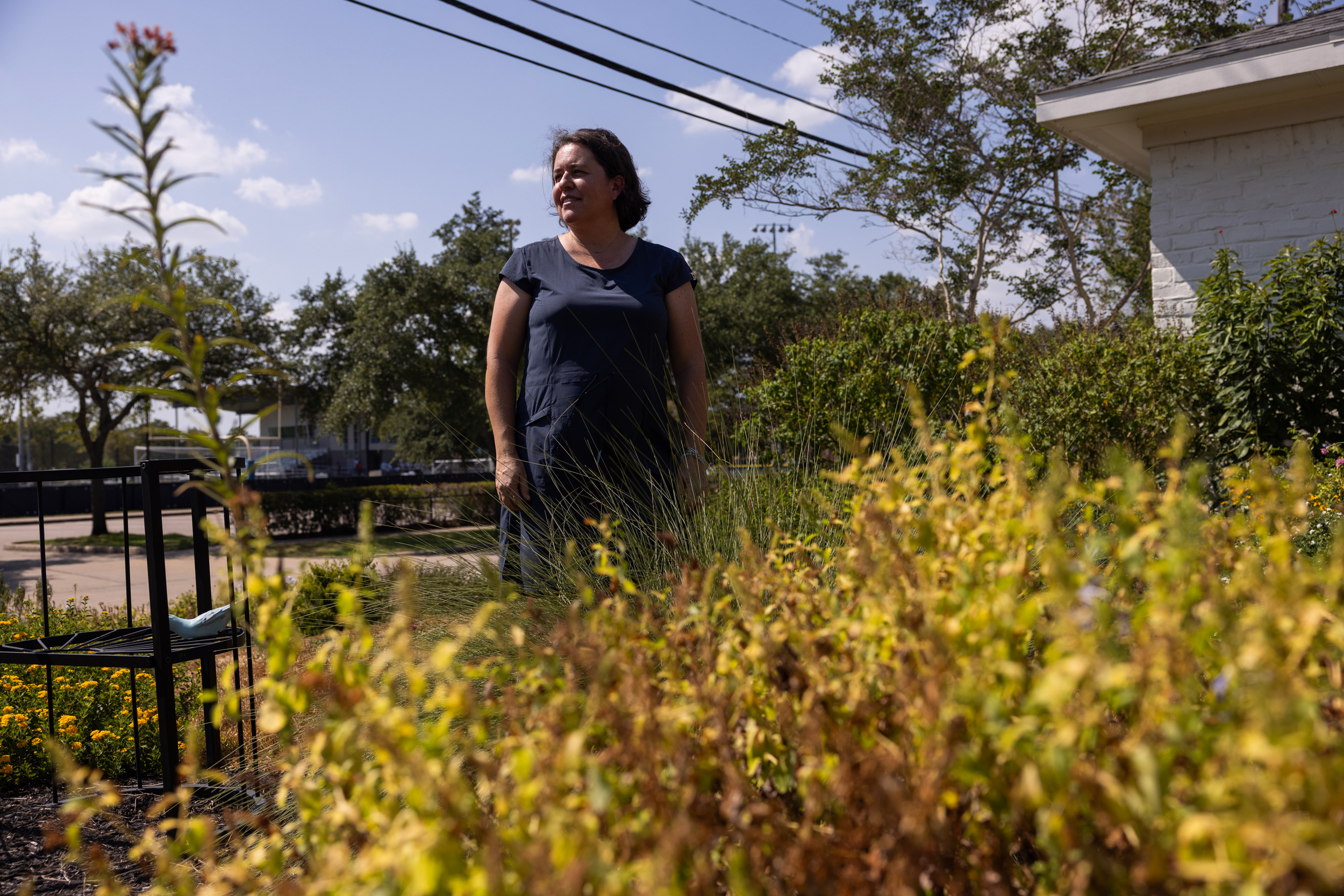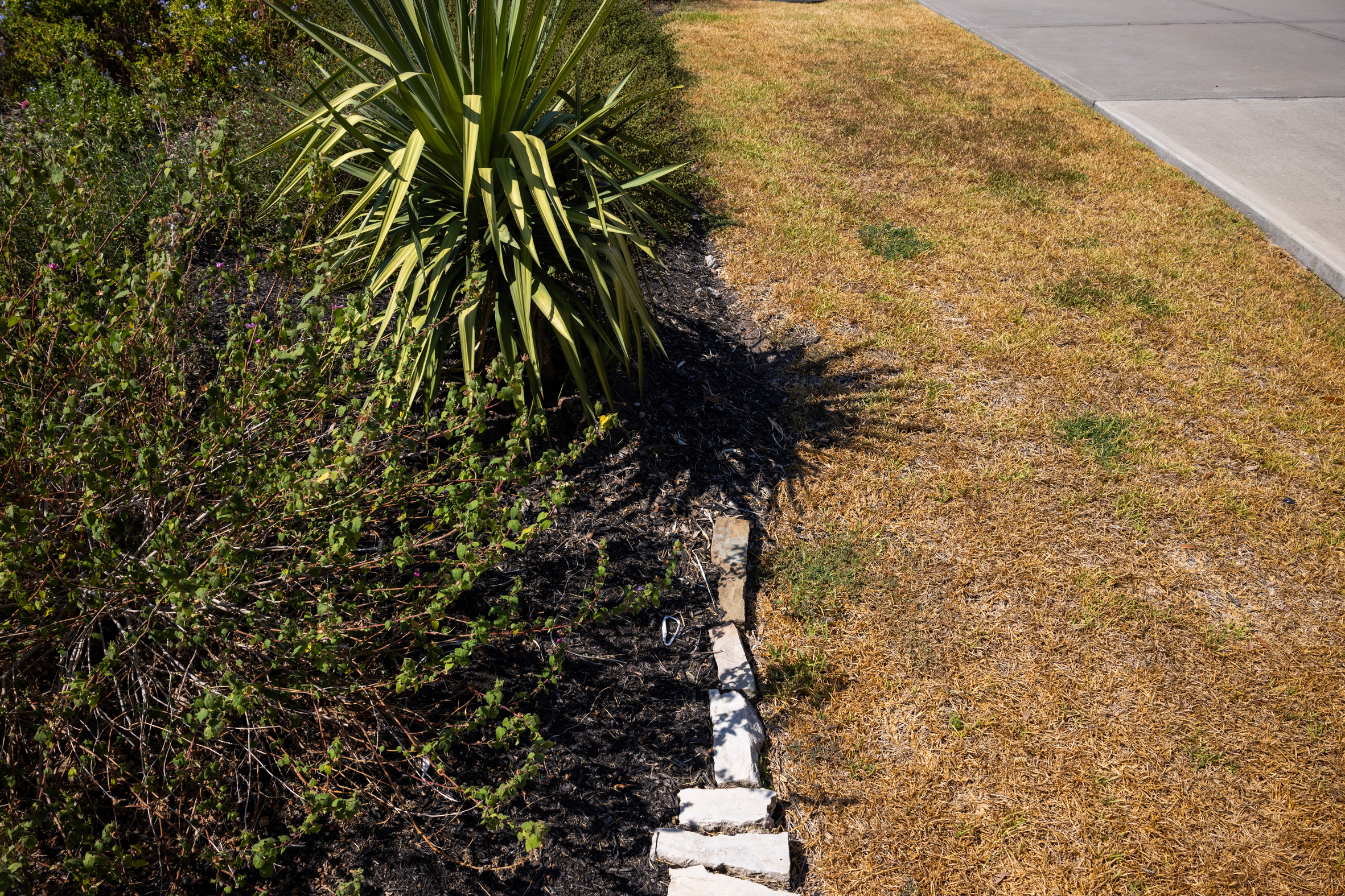|
Getting your Trinity Audio player ready...
|
Aside from a patch of grass used for a pathway, Claudia Schnelle’s front yard is filled with flowers, native plants and stones at her home in Braeswood Place. Schnelle decided to begin planting native plants in 2011 when Houston had stretches of no rain and record-breaking hot temperatures.
Schnelle has planted each one by herself and says she hardly waters them. Prior to two weeks ago, she had not watered them for about two years.
“I'm sure they'll come back but they're very stressed,” she said. “Otherwise, you know, these guys haven't had water in a long time. They survived their freezes. They've survived the drought so far.”
Across the region, drought conditions have worsened, lawns are dying and local officials are imposing watering restrictions. Some residents are looking for ways to lower their water usage.
One option includes xeriscaping, a type of landscaping using native, drought-tolerant plants that need less water because the plants can take care of themselves, said Joshua Carnegie, owner of Joshua’s Native Plants.
The benefits of adding native plants to one’s yard
Since the end of May, Carnegie has seen an increase in interest in xeriscaping at his wholesales plant shop where people go to find Texas native plants.
“Thirty years ago, I had to talk people into buying this stuff,” he said. “Now, they’re begging for it.”
This year’s drought has led to more water usage as residents try to keep their lawns and gardens green.
“A lot of people waste water with St. Augustine grass and hybrid roses, things that need a lot of fertilizer and constant watering,” Carnegie said. “We are the opposite of that. We deal with indigenous native things and old-fashioned things that your grandmother may have had. Things you just can’t find in the industry anymore.”
Deciding what native plants to use in one’s yard
A lot of people use agaves, cactus and yuccas and succulent plants in California, but Carnegie has seen this become a trend in Texas.
“We have always sold native Texas plants that are indigenous to our great state, that take a lot less watering and you don’t have to use special soils or fertilizers or chemicals,” he said. “They pretty much are native to our area so that’s always been popular, but that’s been increasing over the years.”
Some native plants used in xeriscaping include perennials and salvia, which can also attract wildlife like songbirds, butterflies and bees.
Jeff “River” Law, owner of Kabloom Landscape Design, said Houston is at the crossroads of about five ecozones, meaning there are a variety of plants that can withstand a midsummer drought or a four-day freeze.
A lot of it depends on when an individual plants them and how well the owner takes care of them after the landscape team leaves, Law said.
“It’s like having a kid who goes away to college and you paid for everything and then they move home because you’re still paying for everything,” he said. “So when you cut off pampering, they have to learn to make it on their own and 90 percent will.”
If someone wants a beautiful garden, they will have to learn how to do some watering themselves, at least the first three years, which is how long it takes plants to establish, he said.
People often believe that xeriscaping is solely gravel and rocks but Law said that’s not true.
In Houston, he doesn’t like to plant later than October or earlier than March – just to be sure that any potential freezes are over.
“I did one job one time in December. It was a really warm winter. It was a big job and I planted everything, all her gardens and beds and grass,” he said. “It snowed the next week.”
How to take care of plants in your yard
For people wanting to start adding native plants to their yard, Schnelle said to start little by little and do some research.
She recommends people reaching out to their master gardeners, who have gone through the Texas A&M Master Gardener extension program. Master gardeners, who are volunteers, have gone through training like lawn care and water conservation, and can answer questions from community members.
Once settled, the plants don’t need to be watered often. Additionally, Schnelle recommends researching the full growth size of the plant prior to planting plants next to each other.
“When you buy something new it’s small,” she said. “You plant it and you think everything looks very empty so you plant very close together but just research what will be the mature size. If it’s a tall plant, plant it in the back.”
Although she recommends conducting research before gardening, she said people can always remove a plant from its original spot and replant them in a new place if needed.
What state law says about changing a yard’s landscape
A property owner’s association cannot prohibit or restrict a property owner from using drought-resistant landscaping or water-conserving natural turf, according to the Texas Property Code.
“We do have interest from our homeowners in xeriscape from time to time,” said Amy Roberts, community manager at the Memorial Parkway Community Association. “We do work with our homeowners by allowing certain types of landscape solutions when they are struggling to keep grass alive.”
In certain areas, residents do have to receive approval from their HOAs before initiating any change to their yard.
“Our HOA requires that any changes to the original structure or landscaping of the property be approved by our architectural committee,” said Kathleen Scheps, president of the Lakes at Mason Park’s Community Association.
Law said he promotes xeriscaping to HOAs because sometimes their restrictions can be bad for the environment.
“Even though that may look satisfying to the HOA people, it’s not really a healthy environment for the birds, bees, bugs, butterflies, earthworms, microbes – those are the things that keep a yard alive,” he said.






